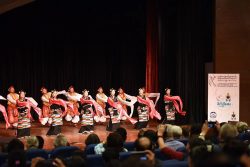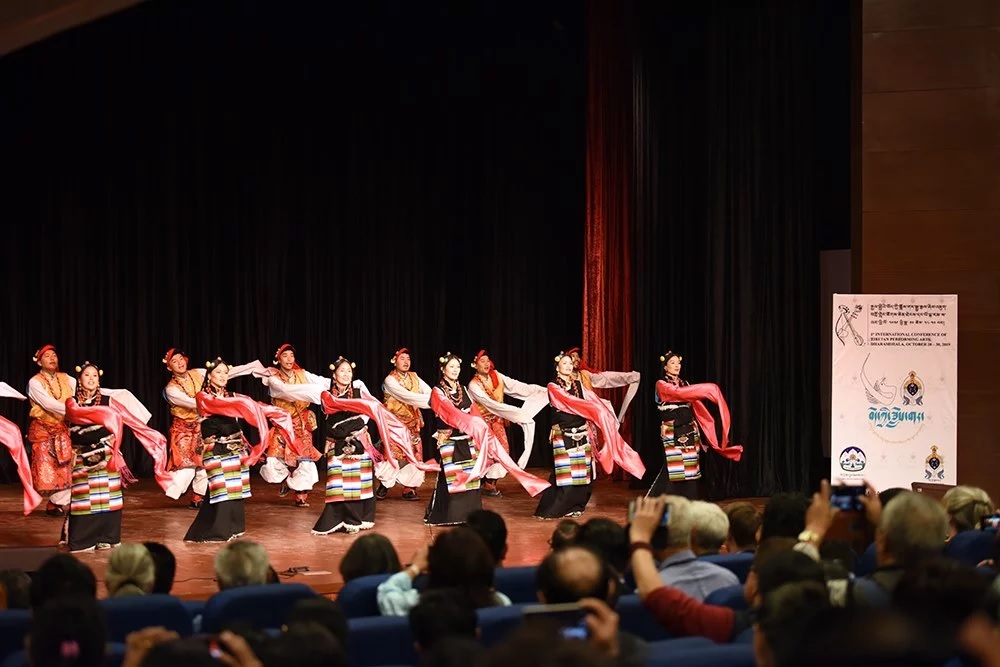
Dharamshala: In the most extraordinary show of support for the rich and revived culture, art and religion of Tibet, the US Ambassador at large for International Religious Freedom, His Excellency Samuel D Brownback, graced the First-ever International conference of Tibetan Performing Arts here in Dharamshala at the special invitation of the President of Central Tibetan Administration (CTA), Dr Lobsang Sangay.
The presence of the head of US state department’s Office of International Religious Freedom marks the highest-level endorsement of the US government in the ongoing efforts towards the revitalisation of Tibetan culture, art and faith in the diaspora.
His Excellency Ambassador Brownback made the strenuous journey from Washington DC to the exile seat of Central Tibetan Administration in north India to deliver a message of hope and inspiration to Tibetans inside Tibet; at the same time, to tell China in clear, definite terms that the US Government prioritises the protection of the inalienable right of religious freedom and condemns its violations at all levels anywhere in the world.
Taking place at the new auditorium of the premier institute for Tibetan arts and culture (TIPA), the International Conference of Tibetan Performing Arts, from 28 to 30 October, is the largest scholastic event to focus solely on Tibetan performing arts and culture. It is being organized by the Tibetan Institute of Performing Arts and the Tibet Policy Institute of CTA. The premier symposium also marks the 60th anniversary of the founding of the Tibetan Institute of Performing Arts (TIPA).
With the presence of the Ambassador Brownback and more than 26 scholars-Tibetan and non Tibetan-from 10 countries invited, this year’s gathering marks the first-ever and the highest-profile convening on Tibetan art and culture in the exile history of Tibet.
Chief guest His Excellency Sam Brownback began his speech extolling the President Dr Lobsang Sangay and his Cabinet (Tib: Kashag) for providing outstanding leadership to Tibetan people and deemed it his honour to join the celebrations and meeting His Holiness the Dalai Lama earlier this morning.
The Religious Freedom Ambassador addressed some of the most critical issues concerning human rights and religious freedom inside Tibet and especially on the reincarnation of the Dalai Lama, on which regard the Ambassador distinctly asserted the sole authority of His Holiness the 14th Dalai Lama and the Tibetan Buddhist system.
“Beijing has long interfered in the succession process of the spiritual leaders in Tibet, most egregiously when 1995 the Chinese government abducted the 11th Panchen Lama when he was 6 years old along with his parents. We call on the PRC government to release immediately the Tibetan recognised Panchen Lama Gedun Choekyi Nyima or share the truth about his faith with the world.”
“We stand with the people of Tibet as they seek to preserve their time-honoured traditions including their right to venerate religious leaders of their choosing. Earlier this month at the 3rd Special General meeting in dharamshala, Tibetans from far and wide underscored the right of the Dalai Lama and other Tibetan leaders to identify and recognise a successor to His Holiness and rejected Chinese authorities to interfere in this process.”
“Let me be clear! The United States shares that view,” Ambassador Brownback said.
“Tibetan Buddhists and all other faith communities should be able to select, educate and venerate their religious leader without government interference. the selection effects not just Tibetans but for the global Buddhist community. Decision regarding the selection of Tibetan Buddhist leaders rests with the Dalai Lama, Tibetan Buddhist leaders and people of Tibet. Period!”
In conclusion, the International Religious Freedom Ambassador made three key appeals to the People’s Republic of China: First, it called on the PRC government to release immediately the Tibetan recognised Panchen Lama Gedun Choekyi Nyima or share the truth about his faith with the world.
Second, it urged the PRC government to change its policies in Tibetan areas that have created this tension. To respect and preserve the distinct religious, linguistic and cultural identity of the Tibetan people and permit Tibetans to express their grievances freely, publicly, peacefully and without fear of retribution.
Lastly, it strongly urged the PRC government to protect the Internationally recognised right to religious freedom to all individuals and respect the human rights of members of all religious group and accordance with China’s Human rights commitments.
On supporting dialogue between the envoys of His Holiness the Dalai Lama and the PRC, Amb. Brownback expressed that the US Government is committed to raising Tibetan issue with Chinese government counterparts at multiple levels and U.S government officials including the Vice President as well as officials from U.S consulate in Chengdu and US Embassy in Beijing continues efforts to establish conditions that laid to direct and meaningful dialogue between PRC authorities and His Holiness or his representatives without preconditions that leads to a sustainable settlement.
“In closing, I commend to you the powerful image of the Snowlion, symbol of Tibet found throughout Tibetan visual and performing arts, paintings and dance joyful, fearless, strong and free. Thank you for your time, thank you TIPA for hosting me and God.”
The President Dr Lobsang Sangay, in his address, thanked profusely the Ambassador Sam Brownback who, despite great challenges, committed to be here at the CTA headquarters to honour the 60th anniversary of TIPA and the first International Conference on Tibetan performing arts.
“I want to thank Ambassador Brownback for being here because this journey took a bit of a complicated route. Initially, the karmic connection was not that clear but the Ambassador worked so hard. He pushed very hard within the State Department and the White House to clear his speech. So in the last three days, everything fell into place, which means, Ambassador, you are bound to be here. That’s the karmic connection. We want to deeply thank Ambassador for making all the efforts to specifically come to the Dharamshala to be with us.”
On behalf of the six million Tibetans inside Tibet and worldwide, President Sangay thanked Ambassador Brownback for his decisive and strong moral leadership in advocating for religious freedom for Tibetan people, Uyghurs and people of faith worldwide.
He said, “Ambassador has been in the forefront advocating for religious freedom for Tibetan people, Uyghurs and for people of faith all around the world. Under his leadership, he organised two ministerial-level conferences on religious freedom and more than 90 countries participated. Both the times, his office made sure that the Tibetan delegation is part of the ministerial delegation. The representative of Office of Tibet in Washington DC and staff members were invited both the times. A former Tibetan political prisoner gave personal testimonies in both the ministerial level conferences.”
The President also referred to the Ambassador’s powerful speech on religious freedom which he delivered at the Foreign Correspondents Club in Hong Kong.
“Salute to you for your courage and moral standing,” the President said.
In the same vein, President Sangay acknowledged and thanked the leadership of US government in advocating for human rights of people in China, particularly the Tibetan people. He referred to the recent speech delivered by Vice President Mike Pence, describing it as “the strongest speech ever by any US leaders on human rights in China”. “Secretary of the State Mike Pompeo has also mentioned Tibetan and human rights in India.”
Speaking on the political significance of the 60th anniversary of the Tibetan premier institute of arts and culture, the President said the design of Chinese occupation of Tibet, from early 1959, was to destroy the source and foundation of Tibetan identity. But from rubbles of complete destruction, the Tibetan Buddhism, culture, language, art and medicine was revived and the major hubs were rebuilt in exile in the last 60 years under the leadership of His Holiness the Dalai Lama and the support of friends around the world. Even inside Tibet, Tibetan Buddhism is fully preserved and revived in personal and social capacities.
President Sangay quoted the 10th Panchen Lama’s 70,000-Character Petition which recorded destruction of 98 per cent of monasteries in the Tibet Autonomous Region and the Tibetan areas incorporated into the Chinese provinces and the mass starvation and imprisonment in Tibet.
He said the Petition clearly proved two important facts: first, that the occupation of Tibet was not a peaceful liberation, it was extremely destructive; Secondly, it debunked the Chinese people’s attribution of the destruction of Tibetan monasteries and nunneries as the aftermath of cultural revolution. The report submitted in 1962 clearly showed that the destruction of the Tibetan religion was more or less completed before the Cultural Revolution which began 1965 onwards.
In 1962, the 10th Panchen Lama made the first major criticism of Chinese policy in Tibet in the form of the ’70,000-Character Petition’ submitted to Mao Zedong. The Chinese government kept the petition as a State secret. Two years later, the Panchen Lama was declared ‘an enemy of the people’ and was imprisoned for nine years and five years under house arrest.
“The situation in Tibet grave and serious. Hence we really appreciate the international participants and encourage you to share your scholarship and knowledge about how rich Tibetan culture was, is and should remain so.”
“In that context, I really appreciate Ambassador Brownback for being here because as far as the Tibetan Administration is concerned, you are one of the highest US officials to have visited Dharamshala.”
“Your presence sends a message that religious freedom is universal, human rights is inherent and democracy is inevitable. By your presence, you are sending a message to Beijing. I think they will hear it loud and clear that the Ambassador and the US government are with the Tibetan people. For this, we are very grateful.”
“You are sending a message of hope and inspiration to Tibetans in Tibet. The six million Tibetans are longing to hear a good and positive news. A person of your standing—former Governor, former Senator, a leader in the Republican Party— to be here, you’re sending a powerful and right message to Tibetans inside Tibet that there is hope and we will struggle with you till basic freedom is restored and faith is granted as a universal freedom. Thank you very much.”
Co-organiser of the event, the Director Ngawang Yonten, Tibetan Institute of Performing Arts (TIPA) delivered welcome address on the occasion and thanked the President Dr Sangay for providing his guidance and visionary leadership in convening the historic International Conference on Tibetan Performing Arts.
“It is an honour for me and the Tibetan Institute of Performing Arts to welcome His Excellency Samuel Brownback, US Ambassador at large for International Religious Freedom to the institute,” Director Yonten said.
“The Conference is very important as it is a part of our institute’s 60th anniversary celebration. The proceedings and outcomes of the conference shall be very informative for our artists and also other research fellow who are interested in Tibetan performing arts and music. I also wish all the participants a wonderful time in Dharamshala.”
The inaugural event concluded with a warm vote of thanks from the Secretary and Director of Tibet Policy Institute and a co-organiser, Tsewang Gyalpo Arya.
Secretary Arya thanked His Excellency Ambassador Brownback for his esteemed presence, following which the members in auditorium rose to give a standing ovation to the Ambassador as a mark of respect and appreciation.
The three-day international conference will be convened by Tashi Tsering Josayma, renowned Tibetan historian and Academic Director of Amnye Machen Institute, Tibetan Centre for Advanced Studies, Dharamshala.




